On Rolling Dough
I’ve been asked about this subject — rolling pie and tart dough — so many times now I think it deserves its own separate post and spot under the Techniques menu. It is the single biggest stumbling block to home baking that I’m aware of. Thousands, I’d even speculate millions, of very well-intentioned bakers get hung up on it, I believe, because of one insidious instruction that can be found in virtually every pie or tart dough recipe: refrigerate dough for at least one hour prior to rolling.
What happens to a round of pie or tart dough when it’s put into the refrigerator? The flour soaks up moisture, sure. The activated gluten in it relaxes, yes. But more than that, it turns rock hard. So what happens when the well-intentioned baker tries to roll it? He thinks to himself as he sets it down on the counter with a clunk: this can’t be right. But he soldiers on, because that’s what the instructions say. So he pulls out his rolling pin and the hunk of dough breaks into clumps as soon as he applies pressure to it. In a panic — the dough is warming! — he gathers up the pieces, presses them together and tries again. The same thing happens. By the third or fourth try, the dough is getting more flexible, but as it starts to roll out, huge cracks appear. Never mind, I’m making progress the baker thinks to himself, and keeps rolling until the dough piece looks like a topographic map of one of the Falkland Islands. At this point, desperate to get the piece(s) into the pan, the baker tries to pick the dough up, only to discover it’s stuck to the pastry board. A spatula is employed, but the pieces break and crumble on their way to the pie plate’s lip. Cursing and berating himself for attempting a task as monumental as rolling pie dough, the baker simply grabs up the scraps and presses them into the pan. THERE, blast it! I’m NEVER doing this AGAIN! So end the pie and tart-making careers of countless home bakers. No wonder muffins have become so popular.
If only more recipe writers could learn to build this single, simple line into their instructions, all this frustration and humiliation could be averted: allow dough to return to near room temperature before rolling.
Friends, it’s that simple. It’s what professionals do, and there’s no reason you can’t do it too. Because there’s no magic in cold dough. There’s magic in chilling dough, but once the benefits of cooling a pie or tart dough have been realized, the only thing cold does is make the job of the dough roller more aggravating. So chill. Then go off and have cold one while the dough warms up a bit, and return with the intention of enjoying the crust rolling and shaping experience. Place your cool yet supple disk of dough on a well-floured piece of parchment paper, dusting it well on top, like so:
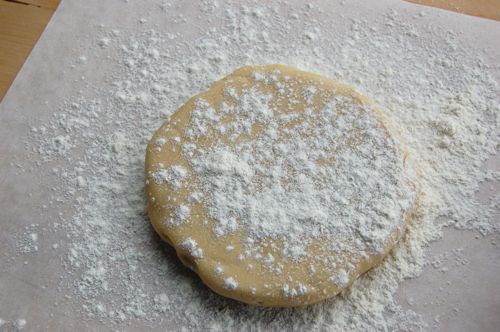
Using a large pin (I like a big, heavy 16-incher for these jobs) roll it to shape, turning the board every so often to help keep the dough piece roughly circular. Ahhhh…

Once the dough is rolled out to about 1/8 of an inch, you’re ready to transfer it to the pan. Placing the pin in the middle of the dough circle (mine’s actually a bit square here…but why fight it?) bring up the parchment paper and drape the dough over the pin.
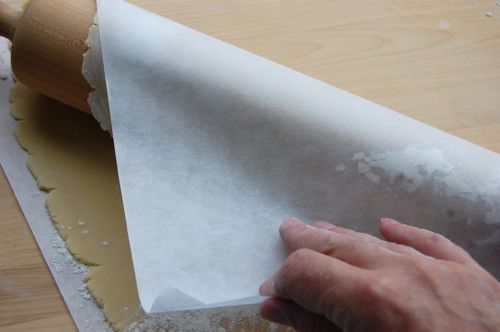
This is where the extra surface area of a big pin really helps. Now then, move the pie/tart pan close…
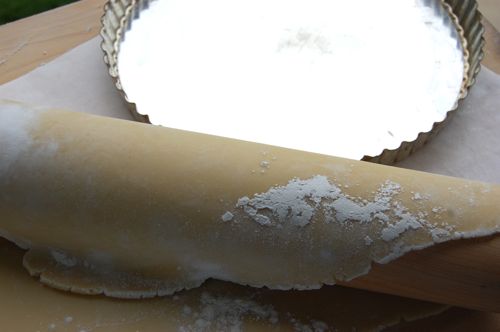
…lift up the dough and lay it on.
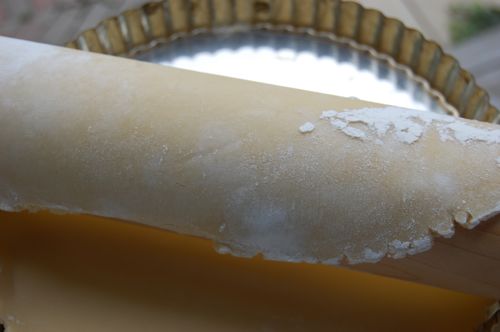
Oops! Turns out the dough tore on the sharp edge of the pan and I have some lip exposed there.
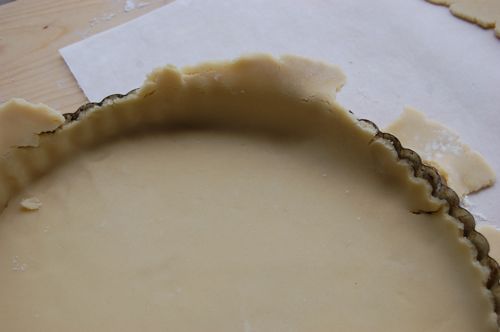
No problem. I just apply a patch. Then I press the dough into the contours of the pan and/or shore up the lip.

Since the dough has been worked a bit as a result of the rolling, pinching and pressing, more gluten has been activated. Rest the dough-lined pan in the refrigerator — if it’s a tart dough I suggest you freeze it — for a minimum of half an hour, preferably an hour. That’ll keep the dough from shrinking up in the oven.
Not so hard when you get right down to it…is it?
Thank you!
I’ve always enjoyed making pies and dreaded making pie crusts. I’ve tried several different crust recipes and watched quite a few tutorials and have always been left wondering “why does my pie crust fall apart and they can not only roll their pie crust, but fold it!” and now I know! So thank you for saving me!
Very glad to be of help, Georgia! Thanks for the email!
Joe! How in the world did you know that this has been my EXACT problem. I bake everything, but between meringue and pies- they are both my nemesis. I honestly thought, because you hear so much about how keeping pie pastry chilled as key, that it was meant to be rolled right out of the fridge! But now thinking about it, of course that is silly, I mean, what did people do to make pies before refrigerators if that were the case? Now, if you can just help me get over my fear of meringue, perhaps I can make a lemon meringue pie for once. Ever since my meringue deflated as I added sugar, I have been weary of it and convinced I could not do it…
Sure thing, Kerri. I’ve had other meringue requests recently. I’ll do a pie or something soon! Thanks for the note! – Joe
Joe,
Thanks again for the great tips.
Was baking strawberry tartlets some weeks back.
Everything went well & my only setback was that the cases looked quite ugly; some are better looking but almost half of the cases sort of shrinked after I baked them.
Now, I know why.
So glad you pointed it out.
Hmmm, my next tartlets will sure look pretty.
cheers, Jacob
Let me know how they go, Jacob!
– Joe
Joe, you’re heaven sent! I’ve been trying to wrap my head around pie/tart dough and what I’m doing wrong and this series may very well save my sanity. Thanks!
Great to hear, Marion! Thanks so much for writing in. How did they finally bake up? OK?
– Joe
Thank you SO much for this article! In two weeks, I’m planning on spending my vacation making soap and baking pies. My most frustrating part of pie-making has been the cracks that form in the edges when I’m trying to roll out the dough. It’s hard to roll out a circle when the edges of the circle insist on breaking off, or form a crack that will split the crust in two. I’ll remember to let it thaw, and to chill it after it’s in the pan. Maybe I’ll spend this weekend making the crusts in advance!
Hey Muzhik!
It is my very great pleasure! And yes, lots of resting time is key with pie dough, and once you get the hang of it rolling will become second nature. Have fun and get back to me with your results!
– Joe
Just found your site by accident, and I am so happy that I did! Silly question. Can you roll out the dough after making it and then put in the fridge or do you need to make the dough, chill the dough, roll the dough, place in tin and then chill again. I would also wonder why some of my pies shrank and some didn’t. This will help during the holidays when I am making multiple pies!
Hey Kally!
The best policy for pie dough it to rest it any time you handle it. After mixing it needs at least an hour rest so the flour can soak up moisture. After that it needs to be rested to allow the gluten relaxes…once it’s rolled, after it’s crimped…whenever it’s manipulated at all. That should keep it from shrinking!
Let me know how your turn out!
– Joe
Thanks!
My pleasure and good luck!
– Joe